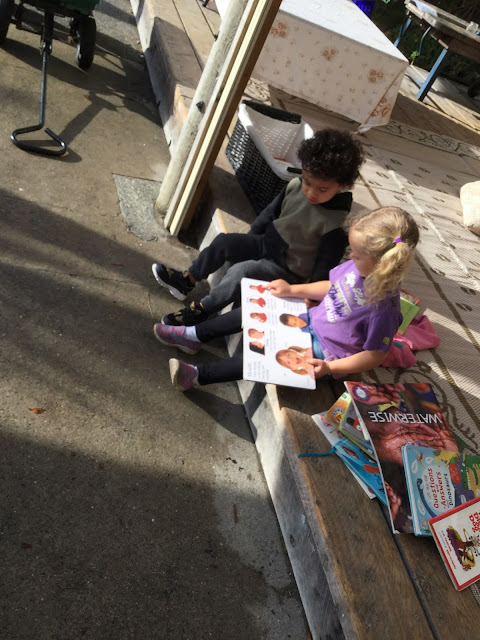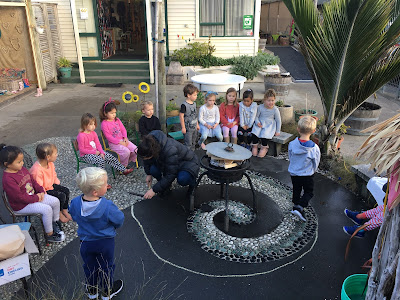Our
Nature Programme is well and truly an embedded part of our kindergarten
programme since starting back in July 2011.
This year has been a bit different with the global pandemic Covid-19
putting our nature programme on hold indefinitely.
As our
nature programme has been going for many years it is something that our
children look forward to as they patiently wait for their turn. For many of our tamariki they have heard all
the stories about the nature programme from the older friends and/or older
siblings. It is something that is
greatly anticipated. With all the
Covid-19 restrictions that have been in place over the past few months, we
started to think that some of our children may miss out on the valuable
experience that the nature programme offers.
“If we really
want children to thrive we need to let their connection to nature nurture
them.” Claire Warden
It is
a privilege to take our children to Mair Park, it is such a beautiful piece of
nature so close to our kindergarten.
When we are there it feels wonderful to be surrounded by our native
ngahere, to take the time to listen, observe, noticing and responding to
changes in the environment. Our tamariki
develop into wonderful kaitiaki (guardians).
Over their time on the nature programme it is amazing to see how they
gain knowledge and an ongoing love of nature and all living things.
Research has
shown that empathy with and love of nature grows out of children’s regular
contact with the natural world. (Department
of Conservation, 2011)
On
Friday 5th June 2020 we were super excited as it was our first
nature programme in nearly three months, since going into lockdown. We had ten excited, enthusiastic and maybe a
little nervous tamariki as we ventured off into Mair Park.
Our
first stop was at a large open grass area appropriately named ‘the
meadow’. As soon as we arrived at the
meadow we all had some morning tea. Then
we went exploring the rock wall, it was tricky to climb as the rocks were wet
and covered in moss. At the meadow the
grass was long and wet which seemed to create a fun opportunity to run and
slide over, roll and lie down on. I
could hear laughing and squeals of delight through this discovery.
A
couple of the children were keen to move onto another area, however there were a
couple that wanted to stay at the meadow.
So we had a vote, the majority rules and moving to the ‘Magic Tree’ won
with eight votes. We put on our bags and
walked to an area with a beautiful massive Puriri tree, aptly named the ‘Magic
Tree’.
The Magic Tree is a lovely place to discover rocks of all sizes, to climb on, or slide on. We found some beautiful leaves and sticks to paint to leave around the Magic Tree. We went on a bug hunt and found lots of different types of fungi and some beautiful spider webs, which were amazing to look at. Mair Park is a vast area with many areas to explore and I love how after all these years I still make new discoveries.
The Magic Tree is a lovely place to discover rocks of all sizes, to climb on, or slide on. We found some beautiful leaves and sticks to paint to leave around the Magic Tree. We went on a bug hunt and found lots of different types of fungi and some beautiful spider webs, which were amazing to look at. Mair Park is a vast area with many areas to explore and I love how after all these years I still make new discoveries.
Hands-on,
informal, self-initiated exploration and discovery in local, familiar
environments are often described as the best ways to engage and inspire
children and cultivate a sense of wonder.
(Department
of Conservation, 2011)
I am
passionate about our nature programme and feel privileged to be part of
it. It is even more special to finally
be back after such a big amount of time away due to Covid-19 restrictions. I’m so happy that our children didn’t
completely miss out on the opportunity to experience the nature programme. There are just so many benefits for our
children, when they connect with nature.
The Department of Conservation states that many studies show the positive links between direct experiences in
nature and children’s mental, emotional, and physical health and
well-being. The studies show that
regular direct access to nature can; increase self esteem and resilience
against stress and adversity. Improve
concentration, learning, creativity, cognitive development, cooperation,
flexibility and self-awareness. (Department of Conservation, 2011).
Mā te
wā
Susie
“Time in nature
is not leisure time; it’s an essential investment in our children’s health.” (Department
of Conservation, 2011)







































































